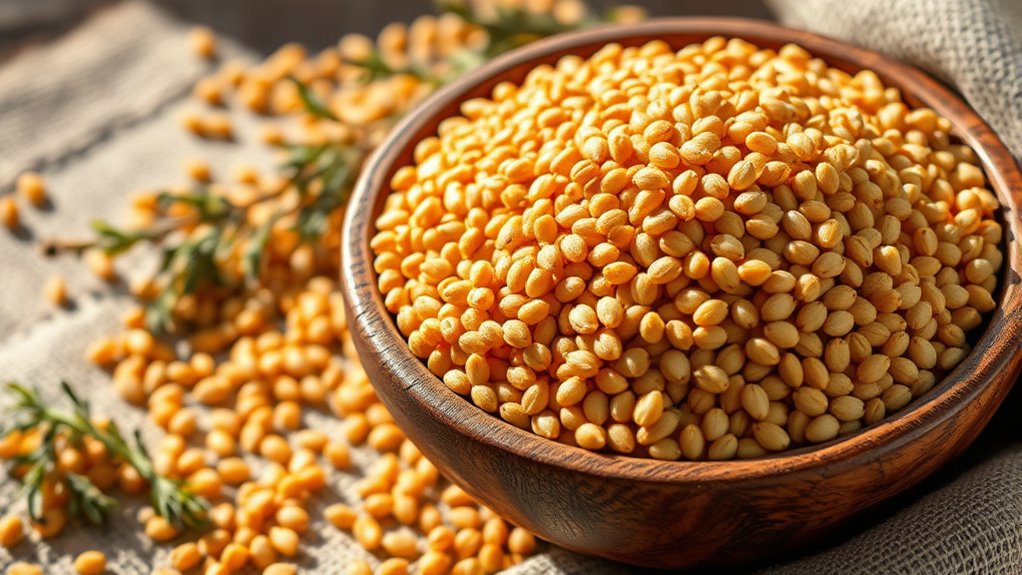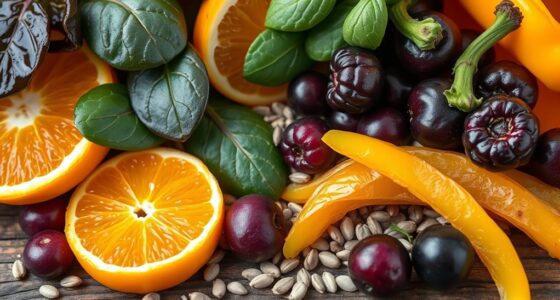If you want sustained energy throughout the day, ancient grains like quinoa and amaranth are excellent options. They’re packed with protein, fiber, and essential minerals that support steady energy release. Quinoa is a versatile, gluten-free choice that cooks quickly, while amaranth provides a nutrient-dense boost. Incorporating these grains into your meals can help you stay energized naturally. Curious how to prepare them for maximum benefits? Keep exploring for some simple tips and tasty ideas.
Key Takeaways
- Quinoa is a nutrient-dense ancient grain that provides sustained energy without crashes.
- Rich in protein, fiber, and minerals like magnesium, supporting continuous energy levels.
- Easy to prepare and versatile, making it suitable for various meals to keep you energized.
- Naturally gluten-free and quick-cooking, ideal for busy lifestyles seeking energy boosts.
- Incorporating quinoa into your diet enhances overall vitality and helps maintain energy throughout the day.

Have you ever wondered if ancient grains can boost your energy levels naturally? If you’re looking for a wholesome way to stay energized throughout your busy day, exploring ancient grains might be just what you need. These grains, long celebrated for their nutritional density, can provide sustained energy without the crash associated with some processed carbs. Plus, many ancient grains are naturally gluten-free options, making them suitable for a variety of dietary needs. Incorporating them into your meals can be simple once you know a few cooking tips, ensuring you maximize their health benefits without any hassle.
Discover how ancient grains can naturally boost your energy and support a healthy, balanced diet.
When considering ancient grains, one of the first things to keep in mind is how versatile they are in the kitchen. For example, quinoa is a popular gluten-free option that cooks quickly and easily. To get the most out of it, rinse the grains thoroughly before cooking to remove any residual saponins, which can give a bitter taste. Use a 2:1 water-to-quinoa ratio, bring it to a boil, then reduce the heat and simmer for about 15 minutes until tender. Fluff it with a fork, and you’re ready to add it to salads, stir-fries, or breakfast bowls. Cooking tips like these help you prepare quinoa efficiently while preserving its nutty flavor and nutrient profile.
Another ancient grain worth trying is amaranth. This tiny seed, also gluten-free, is packed with protein, fiber, and minerals like magnesium, which supports energy production. To cook amaranth, rinse it well, then combine one part amaranth with two and a half parts water. Bring it to a boil, reduce heat, and simmer uncovered for around 20 minutes until it becomes soft and slightly sticky. It works well as a porridge, or you can sprinkle it over vegetables for added crunch. Because amaranth can be sticky if overcooked, keep an eye on the texture and use it promptly to enjoy its full nutritional benefits. Recognizing the nutritional density of ancient grains can help you make informed dietary choices for sustained energy.
Frequently Asked Questions
Can This Grain Help With Weight Loss?
Sure, because eating a mysterious ancient grain will magically melt away pounds, right? In reality, this grain benefits your weight management by keeping you fuller longer and stabilizing blood sugar. It’s not a miracle cure, but it can support your goals when combined with a balanced diet and exercise. So, yes, this grain can be a helpful tool in your weight loss journey, not just a trendy addition.
Is It Suitable for Gluten-Free Diets?
You might wonder if this grain suits gluten-free diets. Its gluten content varies, so check labels carefully. If you’re avoiding gluten due to dietary restrictions, look for certified gluten-free options to guarantee safety. Not all ancient grains are naturally gluten-free, so it’s crucial to verify the product. By reading labels and choosing the right variety, you can enjoy this nutritious grain without compromising your dietary needs.
How Does It Compare to Modern Energy Sources?
When comparing this grain to modern energy sources, you’ll find its grain nutrition offers sustained energy release, unlike quick spikes from processed snacks or sugary drinks. Its fiber and protein content help maintain your stamina longer. You notice that the energy comparison favors this ancient grain, providing steady fuel without crashes. Incorporating it into your diet can boost your overall energy levels naturally, making it a smart choice over many modern, less nutritious options.
Are There Any Known Allergies Related to This Grain?
You might think this ancient grain’s allergy risks are minimal, but surprise—gluten sensitivity and grain allergies can still apply. While it’s hailed for energy, you should watch out if you have sensitivities. Ironically, what’s praised for health might cause reactions in some. So, always check labels and consult your doctor if you suspect allergies. Better safe than energized, right?
What Is the Best Way to Incorporate It Into Meals?
To incorporate this grain into your meals, start with simple meal prep tips like cooking it in bulk for easy use throughout the week. Mix it into salads, soups, or stir-fries for added texture and nutrients. Flavor pairing ideas include pairing it with roasted vegetables, fresh herbs, or a tangy vinaigrette. Experiment with this versatile grain to find your favorite combinations and boost your energy naturally.
Conclusion
So, next time you need a quick energy boost, consider this ancient grain—your secret weapon. It’s like planting a tiny fire within you, burning steadily all day long. By adding it to your meals, you’re fueling your body with nature’s timeless power, helping you stay sharp and energized. Embrace this superfood and watch your day unfold with the vigor of a sunrise, bright and unstoppable. Your energy’s new best friend is just a bite away.









